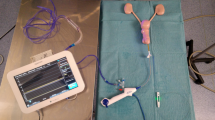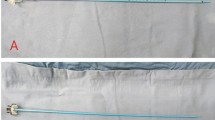Abstract
Purpose of Review
To review the latest evidence about intrarenal pressures (IRPs) generated during flexible ureteroscopy (fURS) and mini percutaneous nephrolithotomy (mPCNL) and present tools and techniques to maintain decreased values.
Recent Finding
fURS and PCNL constitute the primary means of stone treatment. New flexible ureterorenoscopes with small diameter and miniaturized PCNL instruments achieve optimal stone-free rates (SFRs) while decreasing invasiveness and morbidity. Nevertheless, endourologists must remain cognizant regarding the dangers of increased IRPs to avoid complications. Current research presents essential information for urologists regarding this topic.
Summary
During fURS, using a ureteral access sheath (UAS), we avoid extremely high IRPs with all irrigation types. During mPCNL, pressure remains low, mainly using the purging effect or a vacuum-assisted sheath. Devices of intraoperative IRP measurement and intelligent pressure control have proven their feasibility, accuracy and efficacy. These will have an increasing role to play in the future management of stone disease.
Similar content being viewed by others
References
Papers of particular interest, published recently, have been highlighted as: • Of importance •• Of major importance
Zeng G, Zhu W, Liu Y, Fan J, Lam W, Lan Y, et al. Prospective comparative study of the efficacy and safety of new-generation versus first-generation system for super-mini-percutaneous nephrolithotomy: a revolutionary approach to improve endoscopic vision and stone removal. J Endourol. 2017;31(11):1157–63. https://doi.org/10.1089/end.2017.0558.
Zeng G, Zhu W, Liu Y, Fan J, Zhao Z, Cai C. The new generation super-mini percutaneous nephrolithotomy (SMP) system: a step-by-step guide. BJU Int. 2017;120(5):735–8. https://doi.org/10.1111/bju.13955.
Nagele U, Horstmann M, Sievert KD, Kuczyk MA, Walcher U, Hennenlotter J, et al. A newly designed amplatz sheath decreases intrapelvic irrigation pressure during mini-percutaneous nephrolitholapaxy: an in-vitro pressure-measurement and microscopic study. J Endourol. 2007;21(9):1113–6. https://doi.org/10.1089/end.2006.0230.
Schilling D, Gakis G, Walcher U, Germann M, Stenzl A, Nagele U. Minimally invasive percutaneous treatment of lower pole stones with a diameter of 8 to 15 millimeters. Aktuelle Urol. 2009;40(6):351–4. https://doi.org/10.1055/s-0029-1224680.
Desai J, Solanki R. Ultra-mini percutaneous nephrolithotomy (UMP): one more armamentarium. BJU Int. 2013;112(7):1046–9. https://doi.org/10.1111/bju.12193.
Desai MR, Sharma R, Mishra S, Sabnis RB, Stief C, Bader M. Single-step percutaneous nephrolithotomy (microperc): the initial clinical report. J Urol. 2011;186(1):140–5. https://doi.org/10.1016/j.juro.2011.03.029.
Li X, He Z, Wu K, Li SK, Zeng G, Yuan J, et al. Chinese minimally invasive percutaneous nephrolithotomy: the Guangzhou experience. J Endourol. 2009;23(10):1693–7. https://doi.org/10.1089/end.2009.1537.
Song L, Chen Z, Liu T, Zhong J, Qin W, Guo S, et al. The application of a patented system to minimally invasive percutaneous nephrolithotomy. J Endourol. 2011;25(8):1281–6. https://doi.org/10.1089/end.2011.0032.
Landman J, Venkatesh R, Ragab M, Rehman J, Lee DI, Morrissey KG, et al. Comparison of intrarenal pressure and irrigant flow during percutaneous nephroscopy with an indwelling ureteral catheter, ureteral occlusion balloon, and ureteral access sheath. Urology. 2002;60(4):584–7.
Shao Y, Shen ZJ, Zhu YY, Sun XW, Lu J, Xia SJ. Fluid-electrolyte and renal pelvic pressure changes during ureteroscopic lithotripsy. Minimally invasive therapy & allied technologies: MITAT: official journal of the Society for Minimally Invasive Therapy. 2012;21(4):302–6. https://doi.org/10.3109/13645706.2011.595419.
•• Tokas T, Herrmann TRW, Skolarikos A, Nagele U. Pressure matters: intrarenal pressures during normal and pathological conditions, and impact of increased values to renal physiology. World J Urol. 2019;37(1):125–31. https://doi.org/10.1007/s00345-018-2378-4. Review showing the clinical significance of increased intrarenal pressures.
•• Tokas T, Skolarikos A, Herrmann TRW, Nagele U. Pressure matters 2: intrarenal pressure ranges during upper-tract endourological procedures. World J Urol. 2019;37(1):133–42. https://doi.org/10.1007/s00345-018-2379-3. Review showing intrarenal pressure values during kidney endourology.
Falagas ME, Pitsouni EI, Malietzis GA, Pappas G. Comparison of PubMed, Scopus, Web of Science, and Google Scholar: strengths and weaknesses. FASEB journal: official publication of the Federation of American Societies for Experimental Biology. 2008;22(2):338–42. https://doi.org/10.1096/fj.07-9492LSF.
Ng YH, Somani BK, Dennison A, Kata SG, Nabi G, Brown S. Irrigant flow and intrarenal pressure during flexible ureteroscopy: the effect of different access sheaths, working channel instruments, and hydrostatic pressure. J Endourol. 2010;24(12):1915–20. https://doi.org/10.1089/end.2010.0188.
Wright A, Williams K, Somani B, Rukin N. Intrarenal pressure and irrigation flow with commonly used ureteric access sheaths and instruments. Cent European J Urol. 2015;68(4):434–8. https://doi.org/10.5173/ceju.2015.604.
Emre Sener T, Cloutier J, Villa L, Marson F, Buttice S, Doizi S, et al. Can we provide low intrarenal pressures with good irrigation flow by decreasing the size of ureteral access sheaths? J Endourol. 2016;30(1):49–55. https://doi.org/10.1089/end.2015.0387.
Proietti S, Dragos L, Somani B, Butticè S, Talso M, Emiliani E, et al. In vitro comparison of maximum pressure developed by irrigation systems in a kidney model. J Endourol. 2017;31(5):522–7. https://doi.org/10.1089/end.2017.0005.
Yoshida T, Inoue T, Abe T, Matsuda T. Evaluation of intrapelvic pressure when using small-sized ureteral access sheaths of ≤10/12f in an ex vivo porcine kidney model. J Endourol. 2018;32(12):1142–7. https://doi.org/10.1089/end.2018.0501.
Noureldin YA, Kallidonis P, Ntasiotis P, Adamou C, Zazas E, Liatsikos EN. The effect of irrigation power and ureteral access sheath diameter on the maximal intra-pelvic pressure during ureteroscopy: in vivo experimental study in a live anesthetized pig. J Endourol. 2019;33(9):725–9. https://doi.org/10.1089/end.2019.0317.
• Doizi S, Letendre J, Cloutier J, Ploumidis A, Traxer O. Continuous monitoring of intrapelvic pressure during flexible ureteroscopy using a sensor wire: a pilot study. World J Urol. 2020. https://doi.org/10.1007/s00345-020-03216-w. Recent study demonstrating a continuous intrarenal pressure monitoring method during ureteroscopy in humans.
• Doizi S, Uzan A, Keller EX, De Coninck V, Kamkoum H, Barghouthy Y, et al. Comparison of intrapelvic pressures during flexible ureteroscopy, mini-percutaneous nephrolithotomy, standard percutaneous nephrolithotomy, and endoscopic combined intrarenal surgery in a kidney model. World J Urol. 2020. https://doi.org/10.1007/s00345-020-03450-2. First study comparing all endoscopic renal stone treatment options in terms of intrarenal pressures.
MacCraith E, Yap LC, Elamin M, Patterson K, Brady CM, Hennessey DB. Evaluation of the impact of ureteroscope, access sheath and irrigation system selection on intrarenal pressures in a porcine kidney model. J Endourol. 2020. https://doi.org/10.1089/end.2020.0838.
Patel RM, Jefferson FA, Owyong M, Hofmann M, Ayad ML, Osann K, et al. Characterization of intracalyceal pressure during ureteroscopy. World J Urol. 2020. https://doi.org/10.1007/s00345-020-03259-z.
Fang L, Xie G, Zheng Z, Liu W, Zhu J, Huang T, et al. The effect of ratio of endoscope-sheath diameter on intrapelvic pressure during flexible ureteroscopic lasertripsy. J Endourol. 2019;33(2):132–9. https://doi.org/10.1089/end.2018.0774.
Tepeler A, Akman T, Silay MS, Akcay M, Ersoz C, Kalkan S, et al. Comparison of intrarenal pelvic pressure during micro-percutaneous nephrolithotomy and conventional percutaneous nephrolithotomy. Urolithiasis. 2014;42(3):275–9. https://doi.org/10.1007/s00240-014-0646-3.
Mager R, Balzereit C, Reiter M, Gust K, Borgmann H, Hüsch T, et al. Introducing a novel in vitro model to characterize hydrodynamic effects of percutaneous nephrolithotomy systems. J Endourol. 2015;29(8):929–32. https://doi.org/10.1089/end.2014.0854.
Nagele U, Walcher U, Bader M, Herrmann T, Kruck S, Schilling D. Flow matters 2: how to improve irrigation flow in small-calibre percutaneous procedures-the purging effect. World J Urol. 2015;33(10):1607–11. https://doi.org/10.1007/s00345-015-1486-7.
Alsmadi J, Fan J, Zhu W, Wen Z, Zeng G. The influence of super-mini percutaneous nephrolithotomy on renal pelvic pressure in vivo. J Endourol. 2018;32(9):819–23. https://doi.org/10.1089/end.2018.0239.
Loftus CJ, Hinck B, Makovey I, Sivalingam S, Monga M. Mini versus standard percutaneous nephrolithotomy: the impact of sheath size on intrarenal pelvic pressure and infectious complications in a porcine model. J Endourol. 2018;32(4):350–3. https://doi.org/10.1089/end.2017.0602.
Huusmann S, Wolters M, Schilling D, Kruck S, Bader M, Tokas T, et al. [Pressure study of two miniaturised amplatz sheaths of 9.5 F and 12 F outer diameter for minimal invasive percutaneous nephrolithotomy (MIP): an ex vivo organ model measurement]. Aktuelle Urol. 2019;50(1):71–5. https://doi.org/10.1055/a-0759-0140.
Wilhelm K, Muller PF, Schulze-Ardey J, Spath J, Suarez-Ibarrola R, Miernik A, et al. Characterization of flow-caused intrarenal pressure conditions during percutaneous nephrolithotomy in vitro. J Endourol. 2019;33(3):235–41. https://doi.org/10.1089/end.2018.0769.
Lai D, Chen M, Sheng M, Liu Y, Xu G, He Y, et al. Use of a novel vacuum-assisted access sheath in minimally invasive percutaneous nephrolithotomy: a feasibility study. J Endourol. 2020;34(3):339–44. https://doi.org/10.1089/end.2019.0652.
Zanetti SP, Lievore E, Fontana M, Turetti M, Gallioli A, Longo F, et al. Vacuum-assisted mini-percutaneous nephrolithotomy: a new perspective in fragments clearance and intrarenal pressure control. World J Urol. 2020. https://doi.org/10.1007/s00345-020-03318-5.
Zhong W, Wen J, Peng L, Zeng G. Enhanced super-mini-PCNL (eSMP): low renal pelvic pressure and high stone removal efficiency in a prospective randomized controlled trial. World J Urol. 2020. https://doi.org/10.1007/s00345-020-03263-3.
Abourbih S, Alsyouf M, Yeo A, Martin J, Vassantachart JM, Lee M, et al. Renal pelvic pressure in percutaneous nephrolithotomy: the effect of multiple tracts. J Endourol. 2017;31(10):1079–83. https://doi.org/10.1089/end.2017.0298.
• Deng X, Song L, Xie D, Fan D, Zhu L, Yao L, et al. A novel flexible ureteroscopy with intelligent control of renal pelvic pressure: an initial experience of 93 cases. J Endourol. 2016;30(10):1067–72. https://doi.org/10.1089/end.2015.0770. Study demonstrating intrarenal pressure control during ureteroscopy in humans.
Zhu X, Song L, Xie D, Peng Z, Guo S, Deng X, et al. Animal experimental study to test application of intelligent pressure control device in monitoring and control of renal pelvic pressure during flexible ureteroscopy. Urology. 2016;91(242):e11–5. https://doi.org/10.1016/j.urology.2016.02.022.
Huang J, Xie D, Xiong R, Deng X, Huang C, Fan D, et al. The application of suctioning flexible ureteroscopy with intelligent pressure control in treating upper urinary tract calculi on patients with a solitary kidney. Urology. 2018;111:44–7. https://doi.org/10.1016/j.urology.2017.07.042.
Chen H, Qiu X, Du C, Xie D, Liu T, Wang G, et al. The comparison study of flexible ureteroscopic suctioning lithotripsy with intelligent pressure control versus minimally invasive percutaneous suctioning nephrolithotomy in treating renal calculi of 2 to 3 cm in size. Surg Innov. 2019;26(5):528–35. https://doi.org/10.1177/1553350619849782.
Yang Z, Song L, Xie D, Deng X, Zhu L, Fan D, et al. The new generation mini-PCNL system - monitoring and controlling of renal pelvic pressure by suctioning device for efficient and safe PCNL in managing renal staghorn calculi. Urol Int. 2016;97(1):61–6. https://doi.org/10.1159/000442002.
Du C, Song L, Wu X, Fan D, Zhu L, Liu S, et al. Suctioning minimally invasive percutaneous nephrolithotomy with a patented system is effective to treat renal staghorn calculi: a prospective multicenter study. Urol Int. 2018;101(2):143–9. https://doi.org/10.1159/000488399.
Deng X, Xie D, Du C, Song L, Huang J, Tan W. A novel technique to intelligently monitor and control renal pelvic pressure during minimally invasive percutaneous nephrolithotomy. Urol Int. 2019;103(3):331–6. https://doi.org/10.1159/000501047.
Rawandale-Patil AV, Ganpule AP, Patni LG. Development of an innovative intrarenal pressure regulation system for mini-PCNL: a preliminary study. Indian J Urol. 2019;35(3):197–201. https://doi.org/10.4103/iju.IJU_261_18.
Jakobsen JS, Holst U, Jakobsen P, Steen W, Mortensen J. Local and systemic effects of endoluminal pelvic perfusion of isoproterenol: a dose response investigation in pigs. J Urol. 2007;177(5):1934–8. https://doi.org/10.1016/j.juro.2007.01.020.
Jung H, Norby B, Frimodt-Moller PC, Osther PJ. Endoluminal isoproterenol irrigation decreases renal pelvic pressure during flexible ureterorenoscopy: a clinical randomized, controlled study. Eur Urol. 2008;54(6):1404–13. https://doi.org/10.1016/j.eururo.2008.03.092.
Jakobsen JS, Jung HU, Gramsbergen JB, Osther PJ, Walter S. Endoluminal isoproterenol reduces renal pelvic pressure during semirigid ureterorenoscopy: a porcine model. BJU Int. 2010;105(1):121–4. https://doi.org/10.1111/j.1464-410X.2009.08678.x.
Author information
Authors and Affiliations
Contributions
T Tokas: Data management, data analysis, manuscript writing. E. Tzanaki: Data management, interpreting data. U Nagele: Interpreting data. B K Somani: Protocol/project development and interpreting data.
Corresponding author
Ethics declarations
Conflict of Interest
The authors declare that they have no conflict of interest.
Human and Animal Rights and Informed Consent
This review does not involve human participants and/or animals.
Additional information
Publisher's Note
Springer Nature remains neutral with regard to jurisdictional claims in published maps and institutional affiliations.
This article is part of the Topical Collection on Endourology
Rights and permissions
About this article
Cite this article
Tokas, T., Tzanaki, E., Nagele, U. et al. Role of Intrarenal Pressure in Modern Day Endourology (Mini-PCNL and Flexible URS): a Systematic Review of Literature. Curr Urol Rep 22, 52 (2021). https://doi.org/10.1007/s11934-021-01067-5
Accepted:
Published:
DOI: https://doi.org/10.1007/s11934-021-01067-5




